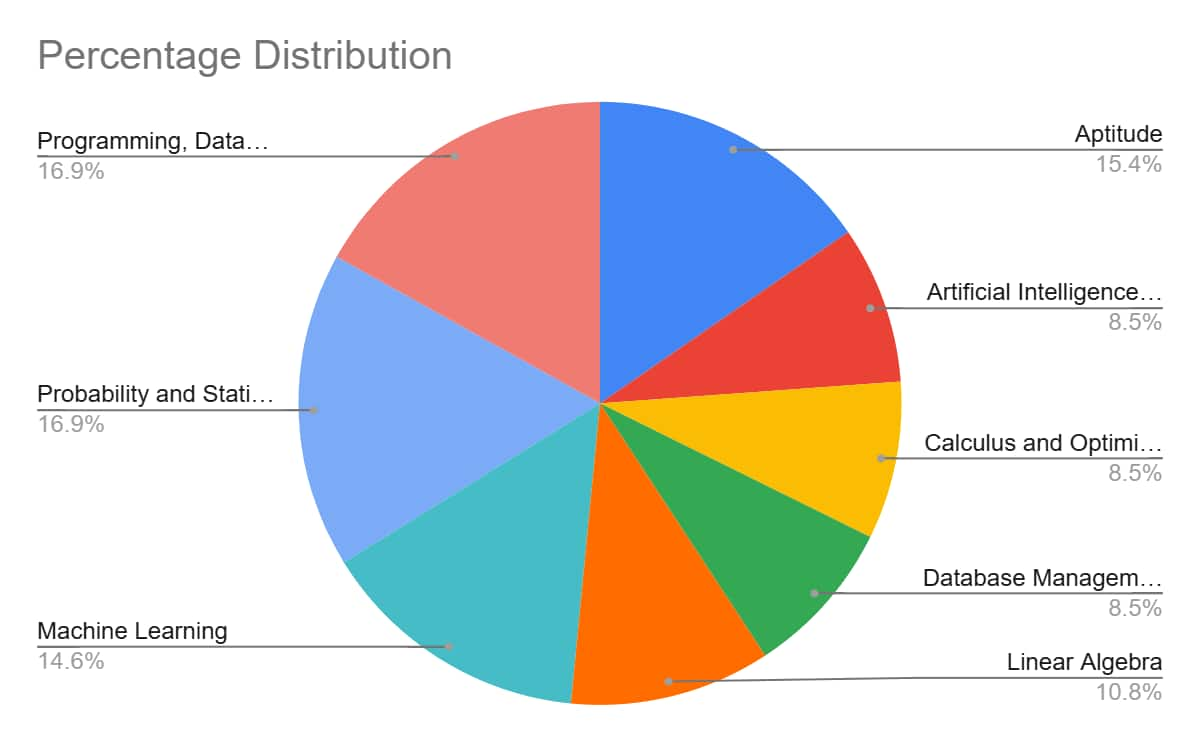| Chapter Name | Topic Name (Specific Subtopic) | Count |
| Aptitude | Dice folding and visualization | 2 |
| Geometry – cross-section visualization | 2 |
| Graph coloring (minimum colors) | 2 |
| Inference from passage | 2 |
| Infinite series sum | 2 |
| Permutations – divisibility | 1 |
| Permutations – Divisibility rule | 1 |
| Pie chart – percentage calculation | 2 |
| Probability of combinations (girls/boys) | 1 |
| Profit/Interest calculation (returns) | 2 |
| Verbal analogy | 2 |
| Aptitude Total |
| 19 |
| Artificial Intelligence | AI – Adversarial search (alpha-beta pruning) | 1 |
| AI – Heuristic admissibility (h1, h2) | 1 |
| AI – Search strategy (A*) and heuristic admissibility | 1 |
| Alpha-beta pruning in adversarial search | 1 |
| Bayesian network – conditional independence | 1 |
| Bayesian network – joint probability computation | 1 |
| BFS vs DFS – state expansion count | 1 |
| BFS vs DFS – state space expansion | 1 |
| Logic representation – rugby and round balls | 1 |
| Neural network – weight equivalence | 1 |
| Propositional logic – tautology identification | 1 |
Artificial Intelligence Total |
| 11 |
| Calculus and Optimization | Function continuity and differentiability (piecewise) | 1 |
| Limits and logarithmic expansion | 1 |
| Limits and logarithmic expansions | 1 |
| Local maxima/minima (quartic polynomial) | 1 |
| Local maxima/minima of quartic polynomial | 1 |
| Logistic function derivative (0.4 value) | 1 |
| Optimization – function continuity and differentiability | 1 |
| Optimization – local minima (2nd derivative test) | 2 |
| Optimization – Taylor series and limits | 1 |
Calculus and Optimization Total |
| 10 |
| Database Management and Warehousing | ER model – relational schema (DB constraints) | 1 |
| Functional dependencies (DB) | 1 |
| Functional dependencies (derivable attributes) | 1 |
| Normalization & z-score | 1 |
| Relational algebra – ensuring team members in defender/forward | 1 |
| Relational algebra – set operations (Team/Defender) | 1 |
| SQL – Index optimization (hash vs B+) | 1 |
| SQL indexing optimization (hash vs B+) | 1 |
| SQL query result count (joins with conditions) | 1 |
Database Management and Warehousing Total |
| 9 |
| Linear Algebra | Determinant of M2+12MM^2+12M | 1 |
| Eigenvalues and matrix properties | 1 |
| Eigenvalues and signs of matrix | 1 |
| Eigenvalues of matrices | 1 |
| Eigenvalues, determinant and matrix property | 1 |
| Matrix rank and nullity (subspaces) | 1 |
| Matrix solution scenarios (unique/infinite/none) | 1 |
| Matrix solutions (unique/infinite/no solutions) | 1 |
| Projection matrix properties | 2 |
| Python recursion & tree traversal | 1 |
| Singular values and sum | 1 |
| Singular values and their sum (SVD) | 1 |
| Subspaces of R3R^3 | 1 |
| Subspaces of R3R^3R3 | 1 |
| Vector subspace properties | 1 |
| Linear Algebra Total |
| 16 |
| Machine Learning | Clustering – single linkage algorithm | 2 |
| Decision tree – Information gain (entropy) | 2 |
| Fisher Linear Discriminant (between/within scatter matrices) | 1 |
| k-means clustering – point assignment | 1 |
| k-means clustering properties | 2 |
| k-NN classifier (minimum k for classification) | 1 |
| ML – Linear separability (2D datasets) | 1 |
| ML – Linear separability of datasets | 3 |
| Naive Bayes – number of parameters estimation | 1 |
| Neural network – weight equivalence (ReLU) | 1 |
| PCA, Naive Bayes, Logistic regression (classification of models) | 1 |
| SVM – support vectors | 1 |
Machine Learning Total |
| 17 |
| Probability and Statistics | Binary search recurrence relation | 1 |
| Covariance between random variables | 1 |
| Dynamic programming (prefix computation) | 1 |
| Expected throws until two consecutive even outcomes | 1 |
| Logic – Propositional representation (balls/rugby) | 1 |
| Poisson distribution & Normal distribution properties | 2 |
| Probability – Bayes theorem | 2 |
| Probability – conditional expectation and variance | 1 |
| Probability – conditional/joint events | 3 |
| Probability – event intersection (T ∩ S) | 1 |
| Probability – expected value (die throws) | 1 |
| Probability – exponential distribution parameter | 2 |
| Probability – joint PDF and expectation | 2 |
| Probability – uniform distribution (X,Y) | 1 |
| Probability – uniform distributions | 1 |
| Probability – z-score normalization | 1 |
| Probability of combinations (girls/boys) | 1 |
| Python list reverse (recursion) | 1 |
| Sample mean update with new data | 1 |
| Sorting algorithms – bubble/insertion/selection passes | 1 |
Probability and Statistics Total |
| 26 |
| Programming, Data Structures and Algorithms | AI – Heuristic admissibility (h1, h2) | 1 |
| Array prefix computation (dynamic programming) | 1 |
| Bayesian network joint probability | 1 |
| Binary search comparisons recurrence | 1 |
| Binary search complexity analysis | 1 |
| Binary tree node relationships (height, leaves) | 1 |
| Binary tree properties (height, nodes) | 1 |
| Covariance between random variables | 1 |
| DFS edge classification (tree/cross/back) | 2 |
| Double-ended queue operations (insert/remove) | 1 |
| k-NN classifier (minimum k for classification) | 1 |
| Python list reverse using recursion | 1 |
| Python recursion – counting tree nodes | 1 |
| Quicksort – swaps count | 1 |
| Relational algebra – SQL tuple verification | 1 |
| Sorting algorithms – bubble/insertion/selection passes | 1 |
| Stack vs queue vs hash table (matching) | 1 |
| Topological sort of DAG | 1 |
| Topological sorting in DAG | 1 |
| Tree traversal combinations (preorder/inorder/postorder) | 1 |
| Uniform hashing – expected probes | 1 |
Programming, Data Structures and Algorithms Total |
| 22 |
| Grand Total |
| 130 |


